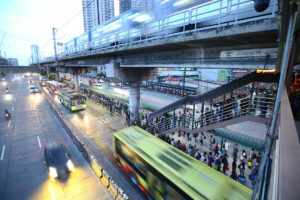THE Management Association of the Philippines (MAP) said the EDSA busway system has demonstrated its potential for moving more commuters, and declared its opposition to a bid by bus operators to revert to the previous practice of picking up passengers waiting along the rightmost lanes.
In a statement on Thursday, the business group said the government should instead focus on completing and upgrading the EDSA busway in partnership with the private sector. The statement was signed by MAP President Benedicta Du-Baladad and MAP Infrastructure Committee Chairman Eduardo H. Yap.
“The MAP likewise strongly opposes the proposal of the bus operators for the simple reason that for the past three years, it has been demonstrated that the EDSA Busway and Bus Carousel Line system is a far superior public bus transport system as it was able to carry a one-day peak load of 454,649 passengers on Dec. 27, 2022 using no more than 550 bus units running on just one innermost busway lane, with more spare system capacity to meet higher demand,” MAP said.
“We earnestly urge the Department of Transportation (DoTr) to stay the course and expedite the completion of this project, preferably, in partnership with a private concessionaire, while adhering to global standards and best practices,” it added.
The Mega Manila Consortium of city bus operators proposed to again be allowed use of the two rightmost lanes along EDSA, including the lane currently serving bicycle riders. They cited losses incurred in busway operations and lower bus utilization.
The Metropolitan Manila Development Authority has come out in support of continuing with the EDSA busway system, which limits buses to driving on the leftmost lane and requires passengers from the EDSA center island at designated stops.
According to MAP, the average daily busway ridership totaled 154.10 million between June 2020 and December 2022, while average daily busway ridership was 380,378 during last year’s Christmas season.
“Drivers are better disciplined and they stop only at bus stations and do not linger there. Commuters’ travel time was reduced, allowing them to be more productive at work and enjoy quality time with their families. The busway has also facilitated travel for ambulances and emergency vehicles. This high performance was achieved due to the higher efficiency of the inner lane busway as a people mover,” it said.
The MAP said the capital expenditure on the busway by the National Government was P500 million, which it noted constituted the “lowest capital cost-to-passenger ratio among transit systems.”
The MAP cited the need for a bus exchange system to facilitate the transfer of commuters to feeder lines, saying that such a system will help persuade motorists to use public transit more.
“This shift will… decongest EDSA. Car lanes may also be reduced to make way for wider sidewalks to enhance non-motorized mobility and planting of trees. Efficient mass public transport and non-motorized mobility are the long-term solution to traffic congestion as envisioned in the National Transport Plan,” the MAP said.
The MAP said the return of buses to the two rightmost lanes is not ideal in “high-density urban corridors” and will be detrimental to commuters.
“The drivers were impervious to discipline. Buses loaded and unloaded anywhere with impunity, weaving in and out of lanes in chaotic fashion. Reverting to the failed yellow bus lane system will be grossly detrimental to commuters, to bus operators themselves, and to the economy,” the MAP said. — Revin Mikhael D. Ochave

